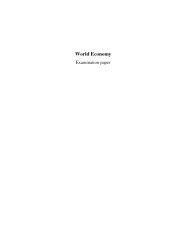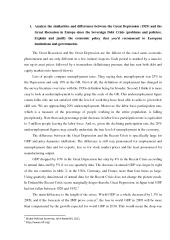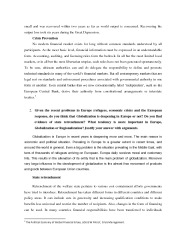World Economy



What caused the crisis? What is the Washington Consensus? The Post-Washington Consensus Era New Hope for Economists? The Euro Advantages and Disadvantages Of A Single Currency. Economic Growth and Inequality The New Post-Washington Consensus. Welfare State, Retrenchment. Olli E. Kangas.
Analyze the similarities and differences between the Great Depression (1929) and the Great Recession in Europe since the Sovereign Debt Crisis (problems and policies). Explain and justify the economic policy that you’d recommend to European institutions and governments.
No modern financial market exists for long without common standards understood by all participants. At the most basic level, financial information must be expressed in an understandable form. Accounting, auditing, and licensing rules form the bedrock. In all but the most limited local markets, or in all but the most libertarian utopias, such rules have not been generated spontaneously. To be sure, ultimate authorities can and do delegate the responsibility to define and promote technical standards in many of the world’s financial markets. But all contemporary markets that are legal rest on standards and enforcement procedures associated with governmental authority in one form or another. Even central banks that we now conventionally label ‘independent’, such as the European Central Bank, derive their authority from constitutional arrangements or interstate treaties.
Globalization in Europe in recent years is deepening more and more. The main reason is economic and political situation. Prevaling in Europe to a greater extent in recent times, and arround the world in general. Even a big problem is the situation prevailing in the Middle East, with tens of thousands of refugees arriving on European. Europe daily receives moral and customary hits. This results in the alienation of its entity that is the main problem of globalization. Moreover very large influence in the development of globalization is the almost free movement of products and goods between European Union countries.
Thus far, we have tended to focus exclusively upon mechanisms identifying economic globalization as the key determinant of the contemporary crisis of the nation state. Yet, arguably altogether more plausible, is a rather more political mechanism. Strictly speaking, this does not so much point to the diminished capacity and sovereignity of the state in an era of globalization,as to globalization of the problems with which the nation state is confronted – an its inability to deal with such problems. Indeed, it points to the more general lack of the political capacity to deal with genuinely global problems and risks that results from the continued ascendancy of the nation state as a political unit.
At first of all it may look like that they are conflicting processes. The very nature of globalization is by definition global, while regionalization is naturally regional. Many economists believe that regionalisation of the world system and economic activity stopping the potential benefits coming out from a liberalized global economy.
The Post-Washington Consensus Era: New Hope for Economists?
The CAP was originally started in 1962 by the predecessor of the European Union, the European Economic Community (EEC). Ackrill (2000) states that this was a process that started in the 1950s, in the after math of World War Two. Food security and increased productivity were some of the primary goals of the cooperation, and real concerns during this time. Europe was not as stable as it is today, and many countries’ productivity and trade had been affected negatively by the war. Keeping this in mind these were the main objectives worked out in the beginning of the CAP according to Andrews (2009):
- Economy & Finance Analysis
- Microsoft Word 51 KB
- 2016 m.
- English
- 18 pages (6300 words)
- Karolics

















